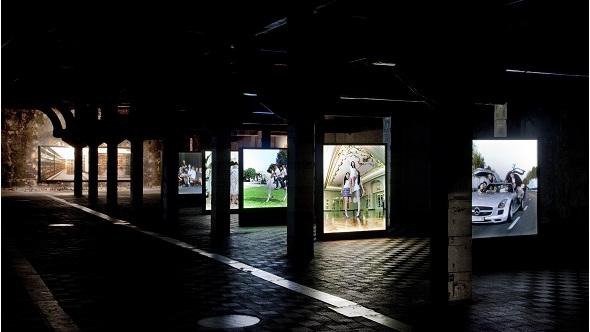31/1/2014
Cristina Lucas / Esther Pizarro
Matadero, Madrid
"Es Capital", by Cristina Lucas, encompasses 4 context-specific work analysing some of the key uncertainties, paradoxes and challenges of the current capitalist system. A Japanese garden joins in the celebrations to mark Dual-Year Spain-Japan 2013/2014 through a project by Esther Pizarro.

Cristina Lucas
ES CAPITAL
Cristina Lucas has chosen the former cold room at Legazpi slaughterhouse as the venue for a context-specific work analysing some of the key uncertainties, paradoxes and challenges of the current capitalist system. Es Capital is curated by Manuela Villa and encompasses four new works created in co-production with AC/E, in collaboration with Centro Galego de Arte Contemporáneo and Museo Patio Herreriano de Valladolid and sponsored by DKV.
Plusvalía documents the investigation undertaken by the artist to understand the value of Capital, written by Karl Marx in the late 19th century and one of the most influential critiques of political economy of our times. In this manuscript, Marx popularises the term "surplus value", which he defines as the profit created by the workers and appropriated by the capitalist. “Without such profit, there would be no capitalist society”, he warns.
The relationship between value in use and exchange value within a society governed by the rules of financial capitalism is also the basis of the work entitled Montaña de oro (Mountain of Gold), two photographs showing the amount of gold that is stored at the Bank of Spain. It is worth remembering that, while the Gold Standard prevailed, this precious metal set the value of a country's monetary unit.
The series of interviews entitled Capitalismo filosófico (Philosophical Capitalism) is an attempt to understand the relationship that exists between the philosophical concepts traded by companies and their business activity. What does Death represent for an undertaker's? What does Beauty represent for a cosmetic surgery clinic? What does Truth represent for a notary public's office?
In El superbien común (The Super Common Good), the artist analyses one of the key paradoxes of the capitalist system: the shortage of resources and our planet's inability to generate sufficient wealth if the entire population aspires to a lifestyle based on an unlimited consumption of goods and services.
------
Esther Pizarro
UN JARDÍN JAPONÉS: TOPOGRAFÍAS DEL VACÍO
Matadero Madrid once more joins in the celebrations to mark Dual-Year Spain-Japan 2013/2014 through this exhibition project from Esther Pizarro curated by Menene Gras Balaguer.
A Japanese garden is a space that encourages contemplation by imitating nature, which it attempts to reproduce in miniature, while sharing aesthetic codes through the use of calligraphy, art and tradition. All the components that make up a Japanese garden include a symbolism and a set of rules that tell us about the meaning of their arrangement, as if they were part of a graphic script with a defined cultural identity. This project produced by Matadero Madrid and Casa Asia delimits the space of the garden over the territorial layout occupied by the country. It is a dry garden surrounded by a sea of salt in which regions have become islands through the creation of paths that run between them, allowing visitors to walk among them as if they were inside a living organism and admire the image of Mother Nature depicted on each representation.
You can visit this unique installation by going along to Nave 16 at Matadero Madrid as from 31 January 2014.
Image: Cristina Lucas
Oficina de Coordinación de Matadero Madrid
Paseo de la Chopera, 14. 28045 Madrid +34 915 179716 comunicacion@mataderomadrid.org
Matadero Madrid
plaza de Legazpi, 8. 28045 Madrid
Hours:
Tuesday to Friday: from 4pm to 9pm
Saturday, Sunday and bankholidays: from 11am to 9pm
Monday Closed



